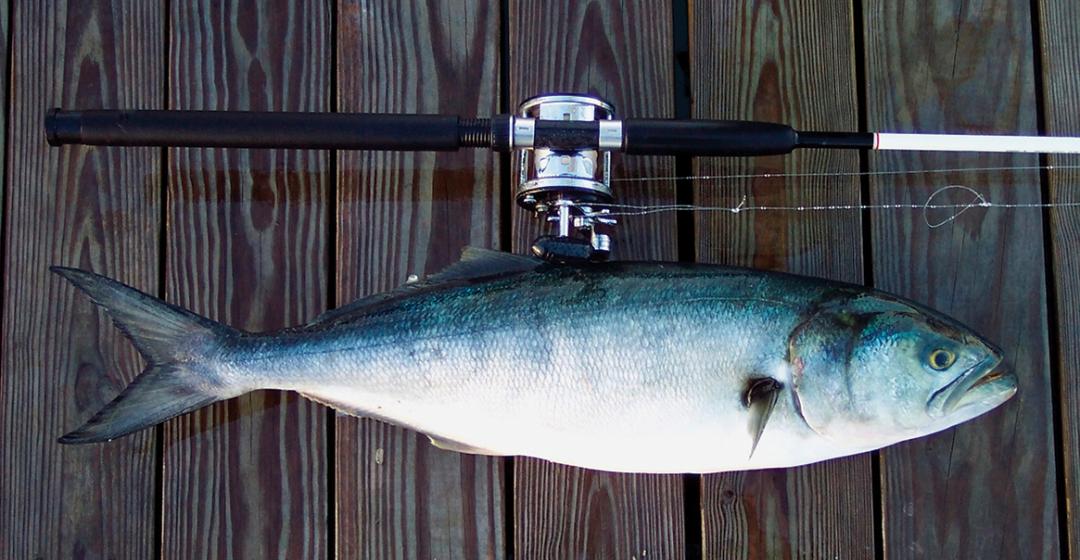This fishing season on Martha’s Vineyard I won’t be able to catch the eight medium bluefish I need to fill my smoker. Nor should I expect to carry home a trophy striper. That’s off the table.
Regulatory changes along the East Coast that reduced bag limits for bluefish and put a slot limit in place for striped bass reflect a sobering reality (one of many lately): fishing for the Island’s premier game fish is not what it used to be.
Remember the good old days? In June, schools of ravenous bluefish, mean and hungry from their long journey up the coast, were plentiful off Chappaquiddick. A fisherman would spot an oily slick, evidence of feeding fish, cast a popping plug and expect several bluefish to charge after it in a rush of snapping jaws.
Lobsterville Beach in Aquinnah was the hotspot for stripers, particularly for fly-rodders who took advantage of the prevailing southwest wind off their backs. As darkness settled in, the uninhibited chugging sounds of larger stripers inhaling bait and singing reels could be heard along the beach.
Well, the good old days were not that long ago. But over the past twenty years, the spring bluefish run slowed to a crawl and finding good-sized stripers on the beach is as difficult as locating a reasonable summer rental.
The Atlantic States Marine Fisheries Commission (ASMFC), made up of fifteen coastal states, is responsible for managing species and implementing management plans along the East Coast. Last year, the ASMFC determined that bluefish had been overfished and mandated a 29 percent reduction in harvest in order to rebuild the stock.
As a result, the daily bag limit for bluefish is reduced from ten fish to three fish for private anglers and five fish for those aboard for-hire vessels.
In the case of striped bass, the ASMFC mandated an 18 percent reduction in the recreational and commercial harvest. States were given some latitude on how to accomplish that goal. Massachusetts opted for the coastwide slot limit.
Recreational fishermen are allowed to keep one striped bass at least twenty-eight inches and less than thirty-five inches in length. Commercial fishermen are allowed fish at least thirty-five inches in length, a one inch increase over the previous minimum size. Fisheries managers said the separation will aid enforcement.
One notable sign of the decline in bass stocks is that in 2019 commercial fishermen landed 586,129 pounds. That represented only 67 percent of the available quota. By contrast, from 2006 to 2014, commercial bass fishermen regularly filled an annual quota in excess of one million pounds.
I will spare you the bouillabaisse of fisheries jargon, committees, and their associated acronyms, but the startling piece of information I found in the ASMFC technical reports (available online) that underpin these changes is how long overfishing has been occurring. With the exception of 2018, bluefish have been overfished dating back to 1985. Striped bass have been overfished since 2013.
To be fair, the overfishing determination is based on a retrospective look at previous data using new modeling techniques. And there was enough earlier concern to spur a reduction in the bag limit from two bass at a minimum of twenty-eight inches to one fish in 2015.
Still, why didn’t fisheries managers act earlier? Island fishermen have sounded the alarm for years that bass were in trouble and action was needed to protect the larger females upon whom the future depends.
Max Appelman, ASMFC fishery management plan coordinator, explained that management decisions are informed by stock assessments, which occur at specific intervals even as new methods of collecting data, and better modeling programs for assessing that data, are brought into play.
“We do what are called benchmark stock assessments. We totally open the book on how we assess the population of a given species. Those come in five-, six-year cycles and a lot can happen in five years in terms of our understanding of the science and the population.”
The ASMFC was acting on a 2016 stock assessment, Appelman said, that showed no overfishing occurring. “A new stock assessment changed our understanding of stock status.”
Another key factor when managing a highly migratory species, he said, is that “what fishermen are experiencing off Martha’s Vineyard could be very different from what fishermen are experiencing off of Delaware or Chesapeake Bay or the coast of North Carolina.”
Sorting out the conflicting claims takes research. And that takes time.
Appelman admitted, “It’s hard to make everyone happy in these very unique and diverse fisheries.”
In March, the Massachusetts Division of Marine Fisheries (DMF) held a public hearing on Martha’s Vineyard to discuss the regulations. DMF acting director Dan McKiernan, who led the hearing, has been at this for a long time. He projects a competence that contradicts the social media rants that have fisheries officials sitting in their offices plotting how to ruin fisheries and fishermen.
McKiernan said that striped bass are a long-lived species, and a combination of angler awareness and two recent strong years of production could portend well for the future.
“Should fishermen be optimistic? Will we see the good old days again?” I asked.
“I hope so,” McKiernan said.





